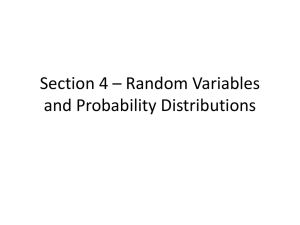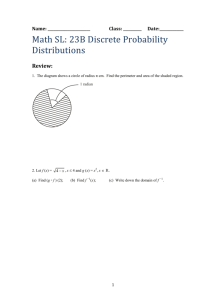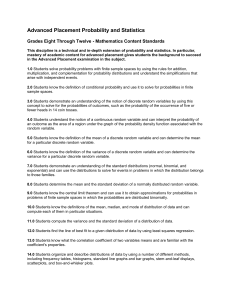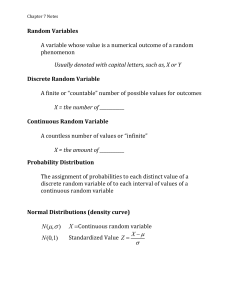probability distribution of a discrete random variable x
advertisement
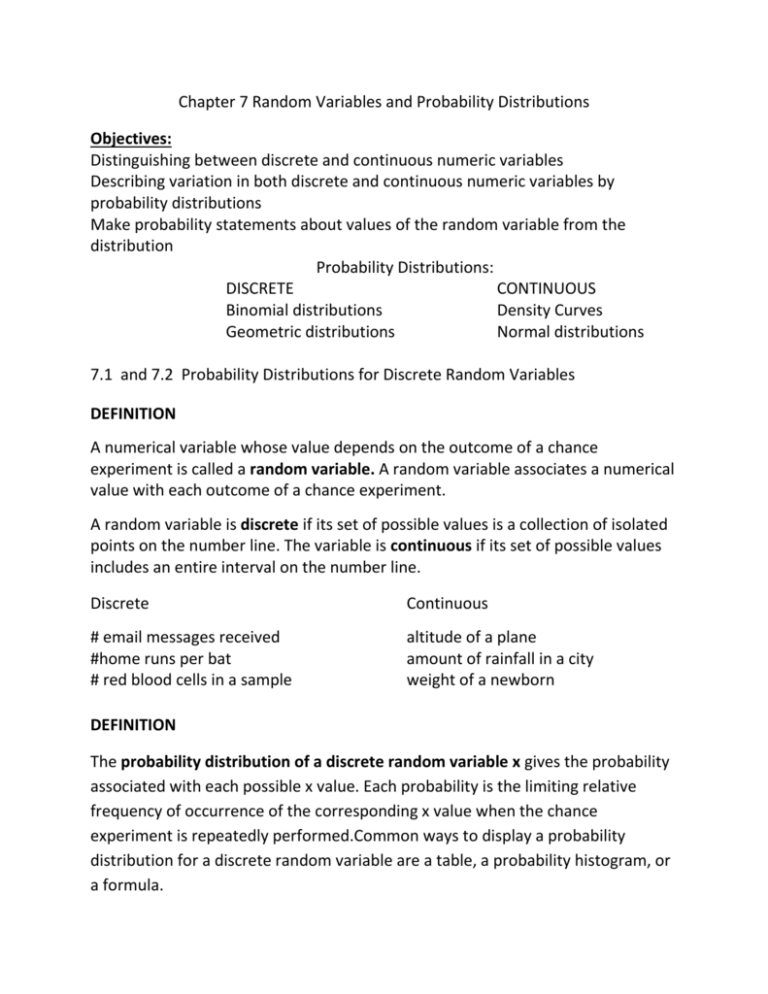
Chapter 7 Random Variables and Probability Distributions Objectives: Distinguishing between discrete and continuous numeric variables Describing variation in both discrete and continuous numeric variables by probability distributions Make probability statements about values of the random variable from the distribution Probability Distributions: DISCRETE CONTINUOUS Binomial distributions Density Curves Geometric distributions Normal distributions 7.1 and 7.2 Probability Distributions for Discrete Random Variables DEFINITION A numerical variable whose value depends on the outcome of a chance experiment is called a random variable. A random variable associates a numerical value with each outcome of a chance experiment. A random variable is discrete if its set of possible values is a collection of isolated points on the number line. The variable is continuous if its set of possible values includes an entire interval on the number line. Discrete Continuous # email messages received #home runs per bat # red blood cells in a sample altitude of a plane amount of rainfall in a city weight of a newborn DEFINITION The probability distribution of a discrete random variable x gives the probability associated with each possible x value. Each probability is the limiting relative frequency of occurrence of the corresponding x value when the chance experiment is repeatedly performed.Common ways to display a probability distribution for a discrete random variable are a table, a probability histogram, or a formula. Review: Probability Rules 1) 2) Discrete Random Variable X= Shirt Size Random Variable X = 6,7,8,9,10,11,12 Probability X # sold 6 85 7 122 8 138 90 154 10 177 11 133 12 92 Cumulative Probability P(X) 1) Construct a probability distribution of the number of shirts 2) What’s the probability that a randomly selected customer will request a shirt of size 8 or less? 3) What’s the probability that a randomly selected customer will request a shirt that is at least an 11? 4) Construct a relative frequency histogram of the discrete probability distribution and cumulative distribution. x x The mean value of a random variable x, denoted by µ x describes where the probability distribution of x is centered. The standard deviation of a random variable x, denoted by σ x describes variability in the probability distribution. When σ x is small, observed values of x will tend to be close to the mean value (little variability). When the value of σ x is large, there will be more variability in observed x values. The mean value of a discrete random variable x, denoted by µ x,, is computed by first multiplying each possible x value by the probability of observing that value and the adding the resulting quantities. Symbolically, µ x = ∑ x • p(x) The term expected value is sometimes used in place of mean value, and E(x) is alternative notation for µ x. The variance of a discrete random variable x, denoted by σ2x is computed by first subtracting the mean from each possible x value to obtain the deviations, then squaring each deviation and multiplying the result by the probability of the corresponding x value, and finally adding these quantities. Symbolically, σ2x = ∑ (x - µ)2 • p(x) The standard deviation of x, denoted by σ x is the square root of the variance. 5) Compute the expected shirt size of a random shopper and the standard deviation of the shirt size. 6) I plans are to order a total of 1,000 shirts, how many shirts of size 8 should be ordered?




